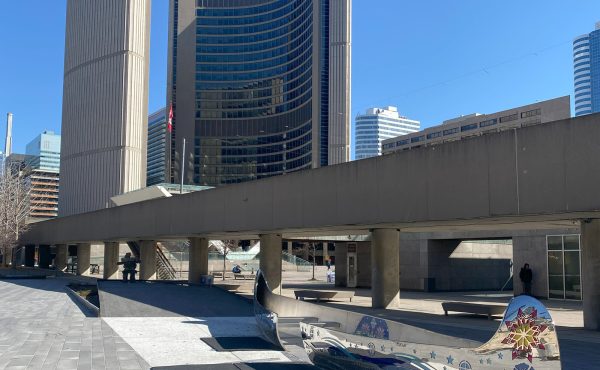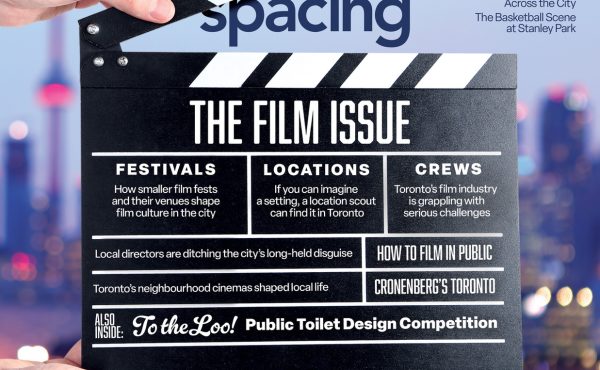
In this month’s Toronto Life, Phillip Preville pens a fascinating article Toronto’s congestion problems, including an interview with Metrolinx chairman Rob MacIsaac. The piece is ostensibly about congestion, but quickly leaps to the means of reducing it: road pricing.
One of the more interesting methods being considered by Metrolinx goes well beyond traditional road tolls or congestion pricing.
A Toronto company called Skymeter Corporation has developed wireless satellite systems that make it possible to record a vehicle’s every move, including its parking times and locations, making both toll booths and parking meters obsolete. Skymeter’s system will soon be tested in the Netherlands, which plans to ditch standard road taxes and replace them with a nationwide per kilometre tax by 2016.
The system is infinitely tweakable for every conceivable detail. Different roads can be charged at different rates, and rates can vary by time of day. Fuel-efficient cars could be charged a lower rate than gas guzzlers. But perhaps the most practical application of the technology—and one being contemplated by MacIsaac—is a parking tax, which would help push cars off the road, since people will be less inclined to drive somewhere they can’t afford to park. A parking tax is also easier to administer, and Skymeter claims it has the potential to generate more revenue than road pricing ever will.
The catch is that all cars would need transponders.
While Preville considers the idea to be politically unfeasible, the technology has generated interest in policy circles.
Still, planners and policy wonks like the idea of pricing the entire grid because they could charge people for all the car trips they should never make: the ones within three kilometres of their home, which they could comfortably walk or cycle. In other words, it would increase the cost of grocery runs or picking the kids up from school. It would also make things like pizza delivery radically more expensive.
There’s more information on Skymeter at the company’s website.
Photo by newyork808




19 comments
This system is very interesting but whereas I don’t think CCTV cameras are a big deal compared to the views of a few who post here, I can see people being alarmed about their movements being monitored in this case. Again, I would not have a problem with it.
I like the idea though that to use the transport pipeline has an immediate cost just like turning on a tap or a light switch. I also like the idea that there is a cost EVERY time one uses a car. I would still use my car when needed and I don’t mind paying to do so.
The comparisons between hydro/water systems are apt. The roads have been a free utility – even though the cars cost a batch to run – it’s still a function of overload as per the Tragedy of the Commons, though it’s the atmospheric commons that are truly abused.
It’s a great picture – near the GO trains and the FSE “fix” to this congestion. But our progressives never bothered to develop and compare a dozen transit options for this quarter-billion project, nor think of using a TDM system like Skymeter.
So we’ve had five years or more of inaction on this critical corridor from the City, but at least Ontario has been Smart, and has extended the GO trains to 12 cars for more congestion relief than either the FSE or the WWLRT, saving a few hundred million maybe.
Weird — I thought the missing link on road pricing was political will, not technology. The 407 transponder/camera system seems to work well, gas stations are already equipped to collect road charges based on fuel consumption, and paid parking lots could easily collect a parking tax. It seems foolish to latch onto a technology with such huge privacy implications when the non-Big Brother alternatives can be made to work nearly as well.
I agree that this sounds like a technology looking for a problem. This is not the only such example — with the kind of money Metrolinx is expecting to spend on transit, every carpetbagger on earth is trying to flog (sorry, promote) some wonderful new scheme.
Given the Ontario Privacy Commission’s feelings about video cameras and tapes, I can just imagine what they would think of a system that could tell you where every car is and was at any instant.
The biggest problem with road pricing is that it assumes we have an alternative in place, and that’s a complete myth.
If people want more money, then just raise gas taxes and license fees. Don’t waste our time and money on complex technology we don’t need.
What is the difference between a road toll on every road and a gas tax?
Mark G: Hundreds of millions of dollars in infrastructure and a costly as hell bureaucracy or private contract.
I’m against road pricing given the current state of our public transit system. GO Trains are bursting at the seams during rush hours, but outside of them, service is sparse or non-existent. The subways are equally crowded and inadequately cover Toronto’s geography, streetcars suffer in congested traffic, there’s no RT to Pearson, Transit City is still just a pipe dream.
Once better alternatives are in place, and the system has the capacity to handle new riders, then road tolls or congestion charges should be considered.
For now, Metrolinx should encourage more carpooling (more HOV lanes everywhere) and focus on improving GO Transit, including better integration with regional transit authorities.
Steve> how come the privacy Commissioner is not worried about cell phones ? THey basically can target our movements as is and people are clammering for the the new GPS phones which will take it to the next level; we take our cells everywhere which we cant do with our cars. Just a thought.
Mark C^ Isn’t this a chicken/egg game you’re playing? How do we pay for better transit without getting a new revenue source like road pricing?
hamish: “The roads have been a free utility(…)”
Not so for drivers who pay numerous hidden and explicit road taxes. Not so even for non-drivers who pay property taxes, a substantial percentage of which go to building and maintaining roads.
Matt L.: “gas stations are already equipped to collect road charges based on fuel consumption”
Gas stations are already collecting this money for the government in the form of fuel taxes. IIRC, 38% of the cost is taxes, according to those little stickers on PetroCan pumps.
Mark G.: “What is the difference between a road toll on every road and a gas tax?”
The difference is that the government would get to collect these new road tolls on top of the existing gas taxes. So they get two hands in drivers’ pockets, instead of one.
I have to agree with the others here who would like to see public transit improved. You really can’t punish people enough to make them stop driving when they have no practical alternative. But give them that alternative and the vast majority of drivers will abandon their cars so fast it’ll make your head spin.
The difference between gas tax and road pricing is differential pricing. The 407 has differential pricing both against the free 401 and *within the same road* based on time.
A gas tax is a good way of raising revenue for overhead – MTO, snow clearing infrastructure – but doesn’t do much for congestion since the tax doesn’t lay much additional burden on those who drive to congested but transit provided neighbourhoods – they burn a bit more gas based on sitting in traffic so there is a minor hit.
As for the chicken/egg – you resolve it by borrowing enough money to both implement congestion pricing and add transit capacity in the congestion neighbourhood.
You use the proceeds from the charge to fund direct repayment on the overall loan as agreed with the lender. That way, you enable additional transit from day one and the people paying the charge know that the charge is funding transit rather than going into general revenue with the additional transit never appearing. Ideally the existing 407 billing systems would be transferred to MTO to operate all road pricing schemes in Ontario rather than people having multiple transponders/bills.
The extra buses – all hybrid to reduce downtown air pollution – could be prominently marked “Funded By Congestion Charge” to ensure visibility and the TTC/City Council barred from using them on routes wholly outside the charge area and other clawback of vehicle purchase commitments.
Isn’t the “catch” that the government would be sanctioned to watch your car’s every move? I agree that it would be much simpler to rely on the taxes on gas — as that would also provide an additional incentive for the use of fuel-efficient vehicles.
Two suggestions to make this work.
First, publicly announce, and make sure to actually follow through with actions, that all of the funding will go to improving public transit.
Second, start improving public transit to anticipate the new pricing system, and start publicising the way the new pricing system works, two years (say) before bringing in the actual pricing. In other words, borrow against, or issue bonds in contemplation of, future congestion-priced revenue — approached conservatively — to invest in present-day transit improvements.
Ooh, just read Mark Dowling above. He said it much better than I.
Taxes make up a lower proportion of gas prices now that the price has increased to the $1/L area, because of the three taxes on gas, only the GST is proportional. The federal and provincial gas taxes are absolute (total about 25c/L). At a price of $1/L, taxes make up about 30%. If gas went up to $1.50/L, taxes would decrease to about 21% of that cost.
Political considerations aside, I see one big flaw in this technology: the ‘every car needs a transponder’ caveat.
What does ‘every car’ mean? Every car registered in the GTA? In Ontario? How do you keep those from outside the registered area from gaming the system, without making the area improbably huge? The 407 uses the licence-plate backup for this very reason; how would this satellite system compensate?
I am inclined to agree with Kevin (and Steve’s first paragraph). We need to think carefully about major complicated technological schemes when there may be simpler, more effective, better enforced, and more cost-effective solutions. In-vehicle transponders works for 407 because it is opt-in, there is a fairly simple backup system (the cameras), it’s on a limited network (cameras/transmitters only at interchanges) etc. In-vehicle transponders for GTA-wide mileage-based tolling would be much more complex, potentially needlessly so.
The advantage of using ETR transponders is that Toronto drivers who previously avoided 407 have an incentive to use it rather than 401 knowing they won’t get one-off charges which are higher than transponder-equipped cars. Ottawa and other cities could then quickly roll out their systems and use the GTA billing back-end. ETR’s billing system isn’t perfect but with so many more users there would be incentive to get it right.
The provided example of wireless billing replacing plate taxes, Holland, has an area of 41526 sq. km and 16.4 million people. Ontario has an area of 1076395 sq. km, 26 times the size, and 12.7 million people. The logistics are far more challenging with a far lower density of road users.
Sounds like some people are advocating a big technological fix which if implemented will likely have some fairly hefty upfront costs (plus ongoing administration costs). Wouldn’t it be better to invest these amounts in beefing up inter-regional transit systems so that we can get people out of their cars? As others above have pointed out, there are other ways of generating the revenue and discouraging driver behaviour without spending an arm and a leg to do so.